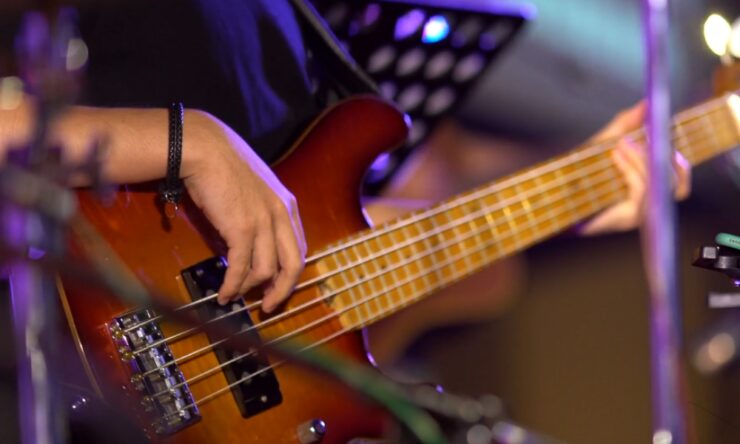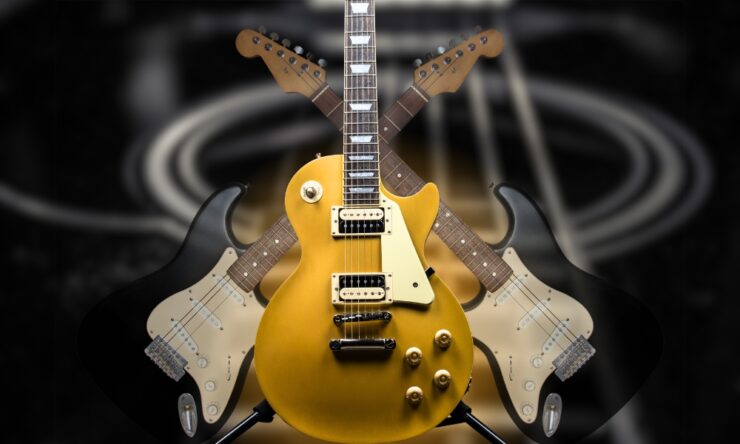Guitars are not a one-size-fits-all instrument. They come in a variety of shapes, sizes, and tunings, each with its unique sound and playing style and you just have to love them for that!
Two such variations are the baritone and tenor guitars. While they may look similar to the untrained eye, these instruments have distinct characteristics that set them apart from each other and from the standard instrument.
Understanding the differences between these two instruments is essential for any musician, whether you’re a beginner looking to choose your first instrument or an experienced player seeking to expand your sonic palette.
Baritone Guitar

This is a unique instrument that sits somewhere between a standard and a bass guitar. It has a longer scale length, typically between 27 and 30 inches, which allows it to be tuned to a lower pitch. This extended range gives this instrument a deep, rich sound that is distinct from other types.
Compared to a standard instrument, the baritone’s lower tuning and extended range allow it to cover a wider sonic spectrum. This makes it a versatile instrument that can handle both bass lines and melody parts.
However, its larger size and heavier strings require a different playing technique, which can be a challenge for players used to standard guitars. Despite these challenges, this type offers a unique sound that can add depth and richness to your music.
Tenor Guitar

The tenor guitar, on the other hand, is a smaller, lighter instrument with a shorter scale length. It typically has four strings, although there are also six-string versions available. This instrument is tuned higher than a standard one, giving it a bright, vibrant sound that is perfect for melodic playing and chordal accompaniment.
Compared to a standard guitar, the tenor’s higher tuning and shorter scale length make it a more accessible instrument for beginners. Its smaller size and lighter strings are easier to handle, and its higher pitch makes it ideal for playing melodies and chords.
Its limited range can be a drawback for players seeking to explore lower registers. Despite its limitations, this is a versatile instrument that can add a unique flavor to your music. Its bright, vibrant sound is perfect for genres like folk, country, and Celtic music, and its compact size makes it a great choice for musicians on the go.
Sound Differences

The baritone guitar is known for its deep, rich tones. Its lower tuning and extended range allow it to produce sounds that are not possible on a standard instrument. This gives the baritone a unique sonic character that can add depth and warmth to your music.
In contrast, the tenor guitar produces bright, vibrant tones. Its higher tuning and shorter scale length give it a crisp, clear sound that is perfect for melodic playing and chordal accompaniment.
While both types have their unique sound qualities, they also share some similarities. Both instruments offer a wider tonal range than a standard type, allowing you to explore new sonic territories.
Playing Styles

The baritone guitar’s lower tuning and extended range make it a versatile instrument that can handle a variety of playing styles. It’s particularly well-suited for accompanying vocals and playing bass lines, thanks to its deep, resonant tones.
The tricky part is that its larger size and heavier strings require a different playing technique, which can be a challenge for players used to standard instruments.
On the other hand, the tenor guitar’s higher tuning and shorter scale length make it a versatile instrument for melodic playing and chordal accompaniment. Its bright, vibrant sound is perfect for strumming folk tunes or picking country melodies.
Tenor’s limited range can be a drawback for players seeking to explore lower registers. Despite their differences, both the baritone and tenor instruments offer a unique range of playing techniques and musical applications.
Genre Suitability

Thanks to their unique characteristics, these instruments are suitable for different genres. The baritone guitar’s deep, rich sound makes it a popular choice for blues, jazz, and folk music. Its lower tuning and extended range allow it to produce powerful bass lines and resonant chords that can add depth and warmth to these genres.
With its bright, vibrant sound, the tenor guitar makes it a popular choice for Celtic, country, and acoustic genres. Its higher tuning and shorter scale length give it a crisp, clear sound that is perfect for playing melodies and chords.
While both instruments have their genre preferences, they are versatile instruments that can be used in a variety of musical contexts.
Fingerstyle vs. Strumming
The baritone guitar is a great choice for fingerstyle playing thanks to its lower tuning and extended range, while the tenor guitar is a responsive instrument for strumming and rhythm playing. Its bright, vibrant sound is perfect for strumming folk tunes or picking country melodies.
However, the tenor’s limited range can be a drawback for players seeking to explore lower registers.
Solo vs. Ensemble

The baritone guitar’s a powerful instrument for solo performances. Its deep, resonant tones can produce powerful bass lines and rich chords that can fill out the sonic spectrum, making it a great choice for solo artists looking for a fuller sound.
In contrast, the tenor guitar’s higher tuning and shorter scale length make it a versatile instrument for ensemble settings. Its sound can add texture and energy to a group’s arrangements, making it a valuable addition to any band.
Instrument Size and Portability
The baritone guitar’s larger size can be a challenge for musicians on the go. Its longer scale length and heavier strings make it a heavier instrument to carry, which can be a drawback for touring musicians or those who frequently travel with their instrument.
Therefore, the tenor guitar’s compact size and lighter weight make it a more portable instrument. Its shorter scale length and lighter strings make it easier to carry, making it a great choice for musicians on the go.
Availability and Cost

The baritone guitar’s unique characteristics and limited availability can make it a more expensive instrument. Its longer scale length and heavier strings require more materials to produce, which can drive up the cost.
Additionally, the baritone’s niche appeal means that there are fewer models available, which can also contribute to its higher price. The tenor guitar’s smaller size and lighter weight make it a more affordable instrument. Its shorter scale length and lighter strings require fewer materials to produce, which can keep the cost down.
Additionally, tenor’s wider appeal means that there are more models available, which can also contribute to its lower price.
Personal Preference and Artistic Expression
Ultimately, the choice between these two types comes down to personal preference and artistic expression. Some musicians prefer the deep, resonant tones of the baritone, while others prefer the bright, vibrant sound of the tenor.
Your choice of instrument can reflect your personal style and artistic vision, adding a unique flavor to your music.
Guitar virtuosos such as Pat Metheny and Derek Trucks have masterfully demonstrated the expressive capabilities of the baritone guitars, pushing the boundaries of its sonic possibilities. Its extended range can offer a unique sonic palette for musicians looking to explore new sounds.
Its deep tones can add depth and richness to your music, making it a great choice for musicians looking for a fresh perspective.
On the other hand, renowned artists such as Bob Brozman and John McLaughlin have showcased the tenor guitar’s melodic potential and its ability to add intricate textures to compositions. This instrument can offer a unique sonic palette for musicians looking to add brightness and energy to their music.
Factors to consider when choosing between the two instruments include the desired sound, playing style, musical genre, personal preference, and the specific musical role the instrument will serve.
FAQs:
Is it possible to switch between playing these two instruments seamlessly?
While the transition may require some adjustment due to the differences in size, tuning, and playing styles, with practice, musicians can develop the ability to switch between the two guitars more easily.
What are the sustainability aspects associated with consuming them?
The sustainability of both instruments depends on the materials used and the manufacturing practices employed. Opting for sustainably sourced and responsibly produced guitars can help minimize environmental impact.
Is it possible to use a capo on both types?

Yes, a capo can be used on both instruments, but it’s important to choose the appropriate capo for the specific scale length and tuning of each guitar.
Can they be easily adapted for left-handed players?
Depending on the availability of left-handed models, baritone and tenor guitars can be adapted for left-handed players through customization or purchasing left-handed-specific instruments.
Can these instruments be used for percussive playing techniques, such as tapping or slapping?
Yes, percussive techniques can be applied to both instruments, allowing for rhythmic and dynamic playing styles to be incorporated into performances.
Conclusion
In conclusion, both the baritone and tenor guitars offer unique sounds and playing styles that can bring a fresh perspective to your music. Choosing the right instrument is an important part of your musical journey. It was such an epiphany for me!
It’s not just about the sound or the playing style, but also about how the instrument fits into your personal style and artistic vision. Try out different models, experiment with different tunings, and see which one resonates with you. You’re sure to discover new sounds and playing styles that will enrich your music.

